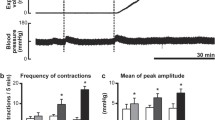Summary
-
1.
Studies have been designed to determine the cause of the increased motor activity of the intestine caused by reserpine in animals. When reserpine was tested on the isolated ileum of various species of animals, it was found to possess moderate anticholinergic activity and some direct relaxant activity. Cholinergiclikc-like or stimulatory effects were completely absent. Essentially the same results were obtained with the isolated colon of the various species.
-
2.
In the anesthetized dog, on the other hand, with or without cervical vagotomy, reserpine elicited a stimulation of the small intestine. In dogs with a cervical vagotomy, hexamethonium in an intravenous dose of 2 mgm./kgm. decreased the stimulation evoked by reserpine.
-
3.
In the anesthetized dog subjected to both a transection of the spinal cord at C-6 and a cervical vagotomy, reserpine caused a stimulation of the small intestine which was largely inhibited by the administration of hexamethonium in a dose of 2 mgm./kgm, intravenously.
-
4.
A mechanism has been suggested to explain the stimulation of the small intestine evoked by reserpine; an action on the parasympathetic ganglia which augments the effect of a reduced central sympathetic inhibitory influence. Increased intestinal and colonic activity is the most likely cause of the diarrhea caused by reserpine in certain animals.
Similar content being viewed by others
References
Anderson, F., Barrett, W. E., Craver, B., Arch. Internat. de Pharmacodyn. et de Therap. 77:544, 1949.
Barrett, W. E., Rutledge, R. A., Rogie, B., Fed. Proc. 13: 334, March, 1954.
Bein, H. J., Experientia 9: 107, 1953.
Bein, H. J., Annals N. Y. Acad. Sci. 61: 4, April 15, 1955.
Muller, J. M., Schlittler, E. and Bein, H. J., Experientia 8: 338, 1952.
Plummer, A. J., Barrett, W. E., Wagle, G. and Yonkman, F. F., Fed. Proc. 12: 357, 1953
Plummer, A. J., Earl, A., Schneider, J. A., Trapold, J. and Barrett, W., Annals N. Y. Acad. Sci. Vol. 59, Article 1, pg. 8, April 30, 1954.
Plummer, A. J., Barrett, W. E., Rutledge, R. and Yonkman, F. F., J. Pharmacol. & Exper. Therap. 108: 292, 1953.
Schneider, J. A., Plummer, A. J., Earl, A. E. and Gaunt, R., Annals N. Y. Acad. Sci. 61: 17, April 15, 1955.
Trapold, J., Plummer, A. J., Yonkman, F. F., J. Pharmacol. & Exper. Therap. 110: 205, February, 1954.
Author information
Authors and Affiliations
Rights and permissions
About this article
Cite this article
Plummer, A.J., Barrett, W.E. & Rutledge, R. The action of reserpine on the motility of the digestive tract. Amer. Jour. Dig. Dis. 22, 337–342 (1955). https://doi.org/10.1007/BF02886462
Received:
Issue Date:
DOI: https://doi.org/10.1007/BF02886462



